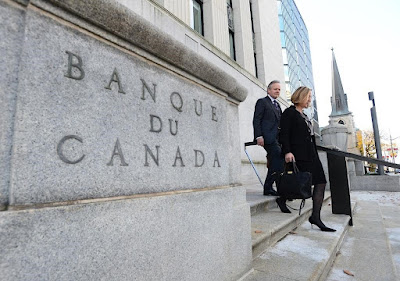(The regular analysis will resume after the New Year. In the meantime, look for several occasional thematic posts over the next couple of weeks. Here is to a healthy and happy New Year!). The dollar recovered from the bout of profit-taking seen after the FOMC largely confirmed market expectations to post a weekly advance against all the major and most emerging market currencies. The omicron variant continues to sweep across the world, and efforts in large parts of Europe and the US to cajole employees into returning to offices were set back. Growth concerns and the confirmation of the hawkish pivot by the Federal Reserve weighed on the dollar-bloc currencies and the Scandia. The fact that New Zealand (November 23) and Norway (December 16) hiked rates for
Topics:
Marc Chandler considers the following as important: 4.) Marc to Market, 4) FX Trends, Featured, newsletter, USD
This could be interesting, too:
Nachrichten Ticker - www.finanzen.ch writes Die Performance der Kryptowährungen in KW 9: Das hat sich bei Bitcoin, Ether & Co. getan
Nachrichten Ticker - www.finanzen.ch writes Wer verbirgt sich hinter der Ethereum-Technologie?
Martin Hartmann writes Eine Analyse nach den Lehren von Milton Friedman
Marc Chandler writes March 2025 Monthly
(The regular analysis will resume after the New Year. In the meantime, look for several occasional thematic posts over the next couple of weeks. Here is to a healthy and happy New Year!).
The dollar recovered from the bout of profit-taking seen after the FOMC largely confirmed market expectations to post a weekly advance against all the major and most emerging market currencies. The omicron variant continues to sweep across the world, and efforts in large parts of Europe and the US to cajole employees into returning to offices were set back. Growth concerns and the confirmation of the hawkish pivot by the Federal Reserve weighed on the dollar-bloc currencies and the Scandia. The fact that New Zealand (November 23) and Norway (December 16) hiked rates for the second time the cycle failed to lend much support. Indeed, along with the Bank of Canada, which may be the next G7 central bank to hike rates, were the three weakest major currencies last week. On the other hand, the Bank of England's surprising hike spurred a short-covering bounce in sterling. Its loss of around 0.2% put it on the top of the pack.
Rate hikes among emerging market currencies offered no guarantee of stronger exchange rates, but Turkey's 100 bp rate cut in the face of a collapsing currency, rising inflation, and the dismissal of a couple deputy ministers saw the lira plunge. The 17.7% loss last week brings the year-to-date drop to nearly 56%. Russia delivered the 100 bp rate hike as widely expected before the weekend, and the rouble still fell (~0.25%) and on the week (-0.8%). Hungary hiked by 30 bp on December 14. The market had been looking for a 40 bp move. Instead, it followed up with another 30 bp in the one-week deposit rate (to 3.6%, doubling the level from the end of October and a three-fold increase since the end of July), and the forint still lost ground against the euro and dollar.
On the other hand, Mexico's central bank hiked by 50 bp while most were expecting a 25 bp move. The peso did strengthen, and for the week, its roughly 0.07% gain gave it top honors in the foreign exchange market. The JP Morgan Emerging Market Currency Index fell in every session last week, for the first time in a couple of months. It dropped nearly 1.7% last week and is at its lowest level since before 2010. It is off about 11.2% this year after falling around 5.7% last year.
Dollar Index: In the last two weeks of November, DXY covered roughly a range of 95.50 to almost 97.00. It has remained in that range this month. This consolidative price action is generally seen as a continuation pattern. To confirm it, the greenback needs to push above 97.00. The next target is around 97.75, which is the high from July 2020 and corresponds to the (61.8%) retracement of the sell-off since March 2020. The MACD is still headed down, but the Slow Stochastic has turned higher. Given the light calendar for the next two weeks, the Dollar Index may continue to consolidate. A break of the 95.50 area could set up a possible double top pattern, whose measuring objective would be near 94.00.
Euro: After falling to a new low for 2 1/2-week low (~$1.1220) in the initial reaction to the FOMC announcement, the euro reversed higher in line with the "buy (the dollar) on the rumor of a less accommodative Fed and sell it on the fact" type of activity we suspected. Follow-through buying lifted the euro to around $1.1360 as ECB President Lagarde's press conference began the next day. That may be all there is, leaving the euro to sulk back toward the lows at the end of last week. In the big picture, we think the risk is on the downside for the euro through the first part of next year and target the $1.10 area. The key driver is the trajectory of monetary policy as reflected in the two-year rate differential. It is a 130 bp -140 bp range. A move to new highs may coincide with the euro making new lows.
Japanese Yen: The doubling of the pace of the Fed's tapering did little to support US 10-year yields, which we argue is the single more important factor for the dollar-yen exchange rate. Increased stock market volatility (equity sell-off) also helped drag yields lower. The 10-year fell to almost 1.37% after approaching 1.55% the previous week. The yield closed lower only once since the September FOMC meeting. The dollar rose above JPY114.00 after the FOMC meeting, but there was no subsequent buying above JPY114.25. The push from lower US yields saw the dollar record a new nine-day low ahead of the weekend near JPY113.15, catching the trendline connecting the late-September and early December lows caught the pre-weekend low. The greenback recovered back toward the session highs, to settle firmly. The momentum indicators are mixed. The MACD has flatlined in its trough, while the Slow Stochastic is trending higher. We had anticipated a JPY113-JPY115 range, but in reality, it has proven half a yen wider in both directions.
British Pound: The outside up day on Wednesday (positioning+Fed inspired) saw follow-through gains spurred by the BOE's 15 bp hike. In the two sessions, sterling rallied almost three cents from a little below $1.3175. It reached the highest level since the omicron variant was sequenced and just shy of the (61.8%) retracement of the leg down from the mid-November high (~$1.3515). The momentum indicators are pointing higher, but sterling traded heavily ahead of the weekend and fell back below the 20-day moving average (~$1.3285). Ahead of the weekend, it was fraying support at $1.3250, and a convincingly break could signal a return to the lows around $1.3160. A sizeable Tory backbench rebellion was turned back, but the loss of the traditional safe seat in the North Shropshire, and the business clamor for more government support, amid reports of the privileges Prime Minister Johnson and his staff during the social restrictions create an uneasy political climate over the holiday period.
Canadian Dollar: The Canadian dollar's 1.2% decline last week led the majors and was the Loonie's largest weekly loss in three months. The greenback spiked to nearly CAD1.2940 on the FOMC announcement before selling off to new session lows around CAD1.2830. Follow-through action the next day saw CAD1.2765. The US dollar recovered to almost CAD1.2880 ahead of the weekend alongside equity market weakness. The MACD did not confirm the high and has flatlined at elevated but not extreme levels. The Slow Stochastic is still trending higher. The swaps market continues to discount around 125 bp in rate hikes next year, which means that a lot of favorable news is already in the prices. Since the September FOMC meeting, the exchange rate has tracked the two-year interest rate differential. In mid-September, Canada offered nearly a 20 bp premium. As the premium widened to about 60 bp by the end of October, the US dollar trended lower, falling from around CAD1.28 to testing the CAD1.23 area in the second half of October. The more hawkish Fed, and given the trajectory of the Bank of Canada that had been discounted, Canada's two-year premium fell back to a little more than 25 bp at the end of last week, and the greenback settled above CAD1.2870.
Australian Dollar: The market remains skeptical of the Reserve Bank of Australia's claim that the conditions will unlikely exist next year to allow a rate hike. The swaps market is pricing in around 90 bp of tightening in 2022, while the futures market has about 85 bp discounted. The Aussie's recovery began after the new lows for the year were set on in early December, slightly below $0.7000. It stalled last week after meeting the (38.2%) retracement objective by $0.7210 for the sell-off that began in late October (~$0.7555). The next retracement (50%) is near $0.7275. Both momentum indicators are trending higher, but the MACD could turn lower. The Aussie finished the week on a soft note around the 20-day moving average (~$0.7140). Nearby support is seen in the $0.7100-$0.7110 area and then around $0.7080.
Mexican Peso: The peso was rewarded for Banxico's 50 bp rate hike that surprised most market participants. The dollar has reversed lower after the FOMC announcement from nearly MXN21.3640 to MXN21.00 and fell to around MXN20.76 after the hike. It slipped lower ahead of the weekend to MXN20.70. A convincing break could sign a move into the MXN20.25-MXN20.50 area. The MACD is still falling, but the Slow Stochastic is bottoming in oversold territory. The market has been emboldened by the hike and expected the new central bank governor to deliver 100 bp in hikes by the end of Q1 22 and 120 bp in Q2. This seems too aggressive and leaves the peso vulnerable to a correction.
Chinese Yuan: The dollar rose against the yuan for the four sessions, matching the longest streak of the year. Still, the gains were minor, and on the first two days of the advance, the greenback rose less than 0.1%. Indeed, the 0.11% rise ahead of the weekend was the most in seven sessions. The greenback rose by 0.08% for the week, its first weekly gain in three. PBOC officials have made their desires clear. The market may have begun getting it, that the path of least resistance may be for a weaker yuan. A closing above CNY6.38 could signal a move, first toward CNY6.40 and then CNY6.42. While the Fed signaled the likelihood of three hikes next year, the PBOC is easing policy. This may include a slight reduction in the one and five-year loan prime rates, which have been stuck since the middle of last year at 3.85% (one-year) and 4.65% five-year loans. Lending to businesses, including property developers and homeowners, is reportedly being encouraged. Fiscal policy is also being engaged. State governments, for example, a being encouraged to tap next year's spending quotas. Officials are also reportedly encouraging the repayment of foreign currency loans. The divergence of US policy on the hand that is pulling away support and China and Japan, the next two largest economies, providing more stimulus, on the other, will be a distinguishing feature of the global economy in the coming quarters.
Tags: #USD,Featured,newsletter







